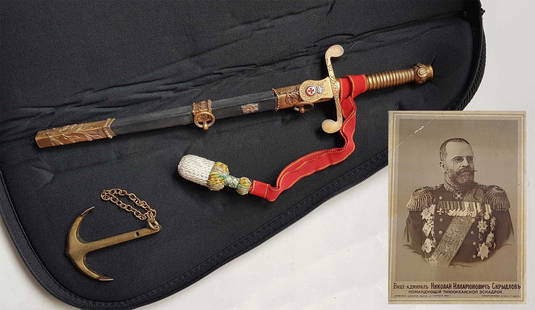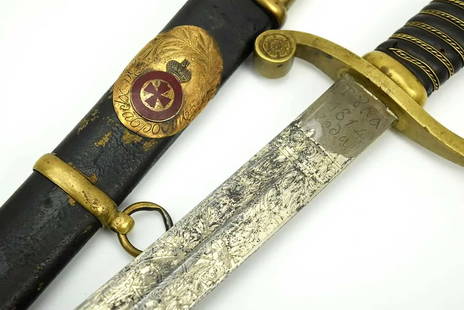
Walrus Trophy Tusks Collected 1931 w/ Plaque
Similar Sale History
View More Items in Militaria & War Memorabilia
Related Militaria & War Memorabilia
More Items in Militaria & War Memorabilia
View MoreRecommended Collectibles
View More










Item Details
Description
North America, Point Hope, Alaska, ca. 1931 CE. A mounted upper part of a walrus skull, including two enormous tusks. The skull is mounted on a wooden backing that reads "Alaska, 1931". Size of skull with tusks: 89" H x 10.75" W (226.1 cm x 27.3 cm); size of each tusk (approximately): 26" H x 2.2" W (66 cm x 5.6 cm); size of skull mounted on backing plaque: 101" H x 13.95" W (256.5 cm x 35.4 cm); size of accompanying plaque: 8.2" H x 10.25" W (20.8 cm x 26 cm).
An accompanying plaque reads, "Walrus head obtained at Point Hope Alaska in 1931 by George M. Gordon while at anchor aboard the ship Cutter Northland."
The walrus is one of the most iconic Arctic animals, instantly recognizable with prominent tusks, whiskers, and bulky, blubber-filled bodies. This example is Odobenus rosmarus divergens, the Pacific walrus, who can grow to more than 2000 kg (4400 lbs). They live in the shallow waters of continental shelves and are highly social animals, often found bellowing and snorting at one another. Part of their social standing is determined by the size of their tusks, and this fellow whose tusks are preserved here would have been a prominent member of his group. Walruses also use their tusks to haul themselves along ice or rock. Males sometimes use their tusks for fighting and have been known to stab each other with them, especially in competition for mates.
Point Hope has long been a place where humans hunted walrus. Located on a spit of land that juts out into the Chukchi Sea, it is famous for a large archaeological site called Ipiutak, which was the center of the Ipiutak culture (ca. 200 BCE to 800 CE), whose people subsisted on a diet heavy in walrus meat and whose houses, when excavated, contained evidence for weapons and tools made from walrus tusk.
The USCGC Northland was a cruising class of gunboat designed for Arctic operations that served in World War II - interestingly, the last cutter built for the Coast Guard equipped with a sailing rig. Each May from 1929 to 1938 she patrolled the Bering Sea, performing a variety of tasks - carrying the mail, gathering military intelligence, performing surveys about timber and wildlife in the area, and, apparently, collecting walrus skulls - before being refitted to patrol Greenland after the invasion of Denmark by the Germans in May 1940.
Provenance: Ex-Vaught Collection, Atlanta, GA
All items legal to buy/sell under U.S. Statute covering cultural patrimony Code 2600, CHAPTER 14, and are guaranteed to be as described or your money back.
A Certificate of Authenticity will accompany all winning bids.
We ship worldwide to most countries and handle all shipping in-house for your convenience.
#120740
An accompanying plaque reads, "Walrus head obtained at Point Hope Alaska in 1931 by George M. Gordon while at anchor aboard the ship Cutter Northland."
The walrus is one of the most iconic Arctic animals, instantly recognizable with prominent tusks, whiskers, and bulky, blubber-filled bodies. This example is Odobenus rosmarus divergens, the Pacific walrus, who can grow to more than 2000 kg (4400 lbs). They live in the shallow waters of continental shelves and are highly social animals, often found bellowing and snorting at one another. Part of their social standing is determined by the size of their tusks, and this fellow whose tusks are preserved here would have been a prominent member of his group. Walruses also use their tusks to haul themselves along ice or rock. Males sometimes use their tusks for fighting and have been known to stab each other with them, especially in competition for mates.
Point Hope has long been a place where humans hunted walrus. Located on a spit of land that juts out into the Chukchi Sea, it is famous for a large archaeological site called Ipiutak, which was the center of the Ipiutak culture (ca. 200 BCE to 800 CE), whose people subsisted on a diet heavy in walrus meat and whose houses, when excavated, contained evidence for weapons and tools made from walrus tusk.
The USCGC Northland was a cruising class of gunboat designed for Arctic operations that served in World War II - interestingly, the last cutter built for the Coast Guard equipped with a sailing rig. Each May from 1929 to 1938 she patrolled the Bering Sea, performing a variety of tasks - carrying the mail, gathering military intelligence, performing surveys about timber and wildlife in the area, and, apparently, collecting walrus skulls - before being refitted to patrol Greenland after the invasion of Denmark by the Germans in May 1940.
Provenance: Ex-Vaught Collection, Atlanta, GA
All items legal to buy/sell under U.S. Statute covering cultural patrimony Code 2600, CHAPTER 14, and are guaranteed to be as described or your money back.
A Certificate of Authenticity will accompany all winning bids.
We ship worldwide to most countries and handle all shipping in-house for your convenience.
#120740
Condition
Skull has dark patina; one of the interior teeth is loose but does not seem in danger of falling out.
Buyer's Premium
- 24.5%
Walrus Trophy Tusks Collected 1931 w/ Plaque
Estimate $2,000 - $3,000
20 bidders are watching this item.
Shipping & Pickup Options
Item located in Louisville, CO, usSee Policy for Shipping
Payment
Accepts seamless payments through LiveAuctioneers

Related Searches
TOP


























![[Ambrotype] Double-Armed w/ Revolvers: Ninth plate hand-tinted & gilt tintype. Leatherette case. Anonymous artist. Striking portrait of a rebel warrior who wears a uniform style commonly associated with the state of Mississippi. Armed with](https://p1.liveauctioneers.com/7226/317626/170485480_1_x.jpg?height=310&quality=70&version=1706368022)
![[Ambrotype] New York Officers w/ Dog: Quarter plate hand-gilt ambrotype. Leatherette case. Anonymous artist. New York [?]. Portrait of a pair of bearded men, possibly brothers, one of whom has his arm around the other. The apparently less](https://p1.liveauctioneers.com/7226/317626/170485457_1_x.jpg?height=310&quality=70&version=1706368022)

![[REES, Charles] Enlistedman w/ Bowie Knife: c. 1862. Sixth plate hand-tinted & gilt ambrotype. Half leatherette case. Charles Rees. Richmond, Virginia. Impressive portrait of a Confederate infantryman who displays a large Bowie knife and musket](https://p1.liveauctioneers.com/7226/317626/170485489_1_x.jpg?height=310&quality=70&version=1706368022)
![[Tintype] Native American Man w/ Knife: Sixth plate hand-gilt tintype. Leatherette case, split at hinge. Anonymous artist. Interior of case inscribed in pencil: "Wade [illegible] / Deputy Sheriff / Bartlesville, Oklahoma, 18[??]” Comp](https://p1.liveauctioneers.com/7226/317626/170485453_1_x.jpg?height=310&quality=70&version=1706368022)

![[Tintype] Officer w/ Virginia Belt Plate: Sixth plate hand-gilt tintype. Half leatherette case. Anonymous artist. Virginia. The bearded subject of this portrait wears a neatly tailored officer’s frock coat with large shoulder insignia.](https://p1.liveauctioneers.com/7226/317626/170485466_1_x.jpg?height=310&quality=70&version=1706368022)

![Captured Bowie Knife w/ Period Note of Provenance: Captured Confederate D-hilt Bowie knife. [Kenansville, North Carolina]: [Louis Froelich factory]. With original metal and leather sheath with affixed period notes. First note with only remnants. Secon](https://p1.liveauctioneers.com/7226/325455/175169154_1_x.jpg?height=310&quality=70&version=1712370394)
![Western Album w/ Lincoln & Rare Views [Kansas]: 40+ carte de visite portraits housed in a Civil War era photograph album. Most of the views are of civilian subjects with photographer's imprints from Chicago, Illinois, Springfield, Illinois, Kansas,](https://p1.liveauctioneers.com/7226/322253/173251612_1_x.jpg?height=310&quality=70&version=1710004847)
![[CIVIL WAR] CSA Hymn Book Trophy of War: Hymns for the Camp. [Raleigh, North Carolina]: [Strother & Marcom], [1862]. 32mo. Original boards. Second edition. Sabin 34134; Parrish & Willingham 8795. Period pencil inscription to front free endpa](https://p1.liveauctioneers.com/7226/325455/175169047_1_x.jpg?height=310&quality=70&version=1712370394)
![[CIVIL WAR] 6th Michigan Cavalry ID Disc w/ Battle Honors: Soldier's metal ID disc with battle honors. Obverse stamped: "James R. Jones / Marshall / Co. B. / 6th Reg. / Mich. / Cavalry." Reverse stamped: "So. Mountain. / Antietam. / Fredericksburg / Chancello](https://p1.liveauctioneers.com/7226/325455/175169057_1_x.jpg?height=310&quality=70&version=1712370394)


![Feud w/ Stonewall Jackson, Important Confederate Letter: Autograph letter signed by Colonel Samuel "Sam" Vance Fulkerson (1822-1862). Winchester, [Virginia], 9 December 1861. 3 pages, 4to, 7 3/4 x 10 in., on blue paper. With original yellow envelope with Wi](https://p1.liveauctioneers.com/7226/325455/175169128_1_x.jpg?height=310&quality=70&version=1712370394)
![[CIVIL WAR] Captured Confederate Photo, Trophy of War: Hand-colored studio CDV portrait of an elegant woman identified as Miss E. Tenyson. [Virginia?], n.d. Period ink inscription to mount recto: "Miss E. Tenyson, Virginia". Period ink inscription to vers](https://p1.liveauctioneers.com/7226/325455/175169046_1_x.jpg?height=310&quality=70&version=1712944213)
![[CIVIL WAR] Soldier's Letter w/ Lincoln CDV: Autograph letter signed by George A. Spencer (1844-1914), Co. I, 7th Rhode Island Infantry. Camp 7, R.I. Vo., Alexandria, Virginia, 20 & 21 May 1865. 4 pages, 8vo, 5 x 8 in. With original magenta pink](https://p1.liveauctioneers.com/7226/322253/173251608_1_x.jpg?height=310&quality=70&version=1710004847)
![[Civil War] Explicit Letter w/ Sapphic Poem: Autograph letter signed by Sgt. John M. Brubaker, Co. E, 9th Pennsylvania Cavalry, to his friend Samuel N. Hamilton, Co. L, 3rd Indiana Cavalry and Col. A, 8th Indiana Cavalry. Headquarters, Halifax,](https://p1.liveauctioneers.com/7226/325455/175168994_1_x.jpg?height=310&quality=70&version=1712370394)
![[Libby Prison] USN Button w/ Incredible Story: Button used by Acting Master William L. Howorth, U.S.N., to smuggle a letter out of the infamous Libby Prison with accompanying letter. Group includes: 1. U.S. Navy 2-piece button. Waterbury, [Connect](https://p1.liveauctioneers.com/7226/325455/175169135_1_x.jpg?height=310&quality=70&version=1712370394)

![[CIVIL WAR]. Soldier's Letter w/ Revealing Racist Remarks, POW Chancellorsville, DOD Annapolis: Autograph letter signed by George S. Hill (1841-1863), Co. I, 27th Connecticut Infantry. Camp near Falmouth, [Virginia], 7 April 1863. 3 pages, 8vo, 6 3/8 x 8 in. George S. Hill of Madison, Connecticu](https://p1.liveauctioneers.com/7226/325455/175169055_1_x.jpg?height=310&quality=70&version=1712370394)

![[CIVIL WAR] Sheffield Knife w/ Silver Handle: Civil War era knife with cast "German silver" cutlery handle. Complete with leather sheath (missing metal tip). Overall 11 in. The blade is marked "Robert Lingard," and "Sheffield." [Civil War, Milita](https://p1.liveauctioneers.com/7226/325455/175169010_1_x.jpg?height=310&quality=70&version=1712370394)






![George Washington Signed Discharge: Partly printed discharge document signed by George Washington, as Commander in Chief of the Armies of the United States. Newburgh, [New York], 4 January 1783. 1 page, ## x ## in. Undersigned by Washin](https://p1.liveauctioneers.com/7226/322253/173251475_1_x.jpg?height=310&quality=70&version=1710004847)
![[Ambrotype] Texas Confederate Soldier: Sixth plate ambrotype. Full leatherette case. Portrait of a possible Texas Confederate soldier. A silver star device was used to pin up the brim of his light-toned headgear, a look often seen in image](https://p1.liveauctioneers.com/7226/322253/173251509_1_x.jpg?height=310&quality=70&version=1710004847)
![[CIVIL WAR] 1st Texas Infantry in Camp: Outdoor half plate ambrotype of the 1st Texas Infantry. Full leatherette case. Significant, large half plate ambrotype of members of the 1st Texas Infantry at ‘Splinterville,’ the regiment’s win](https://p1.liveauctioneers.com/7226/322253/173251512_1_x.jpg?height=310&quality=70&version=1710004847)
![[HANCOCK, John] Washington’s Spy, Officer’s Commission: Partly printed document signed by John Hancock as President of the Continental Congress, for Epaphras Bull (1748-1781). [Philadelphia, Pennsylvania], 10 January 1777. 1 page, ## x ## in. Completed in](https://p1.liveauctioneers.com/7226/322253/173251471_1_x.jpg?height=310&quality=70&version=1710004847)

![[CIVIL WAR] Black Soldier & Wife: CDV-sized tintype photograph WITH gem-sized tintype. Full thermoplastic case. Portrait of an unknown African American Civil War soldier who holds the rank of sergeant. He looks directly at the camera](https://p1.liveauctioneers.com/7226/322253/173251671_1_x.jpg?height=310&quality=70&version=1710004847)
![Historic Einstein Signed Program from Lincoln University Visit: Conferences on Objectives. Lincoln University, [Oxford], Pennsylvania, 3 May 1946. SIGNED BY ALBERT EINSTEIN. Tipped into Horace Mann Bond (1904-1972). The Education of the Negro in the American Socia](https://p1.liveauctioneers.com/7226/322253/173251693_1_x.jpg?height=310&quality=70&version=1710004847)
![[Civil War] Bullet Which Nearly Killed Soldier: Lead bullet encased in gold acorn fob with chain. Finely engraved: "W.D. Fiske / 14th Regt. C V / Fredericksburg / Dec 17, 1863." Acorn approx. 1 1/2 x 1 in. Overall length 6 1/2 in. Published in "Her](https://p1.liveauctioneers.com/7226/325455/175169103_1_x.jpg?height=310&quality=70&version=1712370394)










